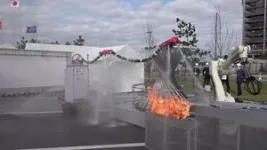(Press-News.org) Imagine a flying dragon that doesn’t spout fire, but instead extinguishes it with blasts of water. Thanks to a team of Japanese researchers, this new kind of beast may soon be recruited to firefighter teams around the world, to help put out fires that are too dangerous for their human teammates to approach.
The blueprint of this novel firefighter robot, called the Dragon Firefighter, has now been published in Frontiers in Robotics and AI. And as it has been published as Open Science, roboticists around the world may freely use the plans to build their own Dragon Firefighters, for the benefit of all.
“We here present a prototype of a four-meter-long, remotely controllable flying firehose robot, engineered to safely and efficiently extinguish fires in buildings by directly approaching the fire sources,” said joint corresponding author Dr Yuichi Ambe, an assistant professor at Osaka University.
A research team from Prof Satoshi Tadokoro's laboratory at Tohoku University began working on similar flying robots in 2016. Since then, 11 researchers and students have contributed to its further development. Prior and during development, they liaised with Japanese firefighters to better understand their needs.
Jet propulsion
The Dragon Firefighter’s firehose is propelled upward (flying at two meters above the ground) by eight controllable jets of water spouting from its center and head. The firehose can change shape and be oriented towards flames, steered by a control unit in a wheeled cart behind. The cart is connected through a supply tube to a fire truck with a water reservoir of 14,000 liters.
The nozzles spout water at a rate of 6.6 liters per second with a pressure of up to one megapascal. The hose’s tip contains a conventional and thermal imaging camera, which help to find the location of the fire.
Goodness, gracious, great balls of fire
The Dragon Firefighter received its baptism of fire at the opening ceremony of the World Robot Summit 2020 (WRS2020), held in September 2021 in Fukushima. There, it successfully extinguished [49 min 00 s to 51 min 00 s] the ceremonial flame, consisting of fireballs lit by another robot, at a distance of four meters. Besides detailing its design, the present study also discusses lessons learned during this first demonstration of the Dragon’s abilities, as well as specifying further improvements made since.
Dr Yu Yamauchi, an assistant professor at Akita Prefectural University and another corresponding author, said: “Since the demonstration at WRS2020, we have continued to work on improving our Dragon and have learned many new things.”
“For example, we found that the original passive dampening mechanism which counters oscillations of the Dragon Firefighter’s body was impractical: it took too long to prepare for flight. We also found that heat from fires can cause detrimental plastic deformation in outdoor applications of the corrugated tube that holds the water hose and electric cables.”
Other improvements detailed in the study include better waterproofing, a nozzle unit capable of handling a wider range of net forces, and an improved mechanism for channeling water flow. But further developments are in the pipeline.
Ready to fly in ten years
“We estimate that it will take approximately 10 more years to deploy our robot in real-world firefighting scenarios,” said Ambe.
“The primary challenge will be to extend its reach to beyond 10 meters. Developing effective firefighting tactics tailored to this robot's unique capabilities will likewise be a critical aspect of further development.”
END
Scientists develop ‘flying dragon’ robot to fight fires from a distance
Flying firefighter robot can be ready for real-world use in the next decade
2023-12-22
ELSE PRESS RELEASES FROM THIS DATE:
Sunday sales reign supreme and other takeaways from review of farmers market transactions
2023-12-21
CORNELL UNIVERSITY MEDIA RELATIONS OFFICE
FOR RELEASE: Dec. 21, 2023
Kaitlyn Serrao
607-882-1140
kms465@cornell.edu
ITHACA, N.Y. – Cornell researchers partnered with New York livestock farmers to analyze transactions at farmers markets, finding that sales were better on Sundays, early in the morning, and during certain months of the year. The study, which researchers believe is the first peer-reviewed analysis of customer-level transaction data at farmers markets, gives new insights into how farmers can make markets more profitable for them.
The researchers and farmers used point-of-sale devices that record sales ...
Palliative care is underused for patients with malignant urinary obstruction
2023-12-21
Less than half of patients with malignant ureteral obstruction (MUO) – a serious complication of advanced cancer, with a poor prognosis – receive palliative care (PC) for their condition, reports a paper in the January issue of Urology Practice®, an Official Journal of the American Urological Association (AUA). The journal is published in the Lippincott portfolio by Wolters Kluwer.
Hospice care can promote patient comfort while avoiding aggressive and invasive treatments for MUO patients nearing the end ...
JCEHP supplement aims to disrupt assumptions about continuing professional development
2023-12-21
December 7, 2023 —The Journal of Continuing Education in the Health Professions (JCEHP) has published a supplement, "Conceptual Advances in Continuing Professional Development in the Health Professions," in which scholars of continuing professional development (CPD) creatively examine prevailing assumptions and propose new theoretical frameworks and empirical insights. Publication of the supplemental issue is supported by the Society for Academic Continuing Medical Education (SACME). JCEHP, the official journal of the Alliance for Continuing Education in the Health Professions, ...
Researchers awarded $3 million to develop AI to better detect aggressive prostate cancer
2023-12-21
Researchers at the UCLA Health Jonsson Comprehensive Cancer Center have received a five-year, $3 million grant from the National Cancer Institute to identify novel cancer biomarkers and develop AI that can detect and predict aggressive prostate cancer to help avoid unnecessary treatments and their associated negative side effects.
Despite recent advancements, prostate cancer remains a common and serious health issue for men, and current methods of screening and risk assessment can often lead to overdiagnosis and overtreatment. About 90% of people diagnosed with prostate cancer receive treatment, even though ...
GPCR structure: Research reveals molecular origins of function for a key drug target
2023-12-21
Through an international collaboration, scientists at St. Jude Children’s Research Hospital leveraged data science, pharmacology and structural information to conduct an atomic-level investigation into how each amino acid in the receptor that binds adrenaline contributes to receptor activity in the presence of this natural ligand. They discovered precisely which amino acids control the key pharmacological properties of the ligand. The adrenaline receptor studied is a member of the G protein-coupled receptor (GPCR) family, and this family is the target of one-third of all Food and Drug Administration (FDA)-approved drugs. Thus, understanding how ...
Structures of Parkinson’s disease-linked proteins offer a framework for understanding how they work together
2023-12-21
Scientists at St. Jude Children’s Research Hospital revealed the complex structure of two Parkinson’s disease-related proteins, both of which are implicated in late-onset cases. Leucine-rich repeat kinase 2 (LRRK2) is a protein kinase that modifies other proteins in a process called phosphorylation; Rab29, a member of the Rab GTPase family that regulates cellular trafficking, modulates the activity of LRRK2. How Rab29 and LRRK2 work synergistically to cause Parkinson’s disease remains ...
Male breast cancer diagnosis fuels groundbreaking treatment tool
2023-12-21
Doctors diagnosed Christopher Gregg, Ph.D., member of the Nuclear Control of Cell Growth and Differentiation Program at Huntsman Cancer Institute at the University of Utah (the U) and neuroscientist and professor of neurobiology and human genetics at the U, with stage 4 metastatic breast cancer in 2018. At that point, he started thinking of ways to improve his treatment.
“The core problem of metastatic cancer is it evolves,” says Gregg. “There may be a treatment that works today but eventually ...
NASA’s Hubble watches ‘spoke season’ on Saturn
2023-12-21
This photo of Saturn was taken by NASA's Hubble Space Telescope on October 22, 2023, when the ringed planet was approximately 850 million miles from Earth. Hubble's ultra-sharp vision reveals a phenomenon called ring spokes.
Saturn's spokes are transient features that rotate along with the rings. Their ghostly appearance only persists for two or three rotations around Saturn. During active periods, freshly-formed spokes continuously add to the pattern.
In 1981, NASA's Voyager 2 first photographed the ring spokes. NASA's Cassini orbiter also saw the spokes during its 13-year-long mission that ended in 2017.
Hubble continues ...
Astronomers detect seismic ripples in ancient galactic disk
2023-12-21
A new snapshot of an ancient, far-off galaxy could help scientists understand how it formed and the origins of our own Milky Way.
At more than 12 billion years old, BRI 1335-0417 is the oldest and furthest known spiral galaxy in our universe.
Lead author Dr Takafumi Tsukui said a state-of-the-art telescope called ALMA allowed them to look at this ancient galaxy in much greater detail.
“Specifically, we were interested in how gas was moving into and throughout the galaxy,” Dr Tsukui said.
“Gas is a key ingredient for forming stars and can give ...
Exercise prescription: Pioneering the "third pole" for clinical health management
2023-12-21
Professor Chen Shiyi's team at Huashan Hospital of Fudan University commented on the concept, policy, development and prospect of exercise prescription in the context of " Health for All", which was published in Research (10.34133/research.0284) under the title of " Exercise Prescription: Pioneering the “Third Pole” for Clinical Health Management".
Modern lifestyles have led to reduced physical activity and a rise in chronic diseases from a young age. Exercise ...
LAST 30 PRESS RELEASES:
Heart-brain connection: international study reveals the role of the vagus nerve in keeping the heart young
Researchers identify Rb1 as a predictive biomarker for a new therapeutic strategy in some breast cancers
Survey reveals ethical gaps slowing AI adoption in pediatric surgery
Stimulant ADHD medications work differently than thought
AI overestimates how smart people are, according to HSE economists
HSE researchers create genome-wide map of quadruplexes
Scientists boost cell "powerhouses" to burn more calories
Automatic label checking: The missing step in making reliable medical AI
Low daily alcohol intake linked to 50% heightened mouth cancer risk in India
American Meteorological Society announces Rick Spinrad as 2026 President-Elect
Biomass-based carbon capture spotlighted in newly released global climate webinar recording
Illuminating invisible nano pollutants: advanced bioimaging tracks the full journey of emerging nanoscale contaminants in living systems
How does age affect recovery from spinal cord injury?
Novel AI tool offers prognosis for patients with head and neck cancer
Fathers’ microplastic exposure tied to their children’s metabolic problems
Research validates laboratory model for studying high-grade serous ovarian cancer
SIR 2026 delivers transformative breakthroughs in minimally invasive medicine to improve patient care
Stem Cell Reports most downloaded papers of 2025 highlight the breadth and impact of stem cell research
Oxford-led study estimates NHS spends around 3% of its primary and secondary care budget on the health impacts of heat and cold in England
A researcher’s long quest leads to a smart composite breakthrough
Urban wild bees act as “microbial sensors” of city health.
New study finds where you live affects recovery after a hip fracture
Forecasting the impact of fully automated vehicle adoption on US road traffic injuries
Alcohol-related hospitalizations from 2016 to 2022
Semaglutide and hospitalizations in patients with obesity and established cardiovascular disease
Researchers ‘listen in’ to embryo-mother interactions during implantation using a culture system replicating the womb lining
How changing your diet could help save the world
How to make AI truly scalable and reliable for real-time traffic assignment?
Beyond fragmented markets: A new framework for efficient and stable ride-pooling
Can shape priors make road perception more reliable for autonomous driving?
[Press-News.org] Scientists develop ‘flying dragon’ robot to fight fires from a distanceFlying firefighter robot can be ready for real-world use in the next decade






